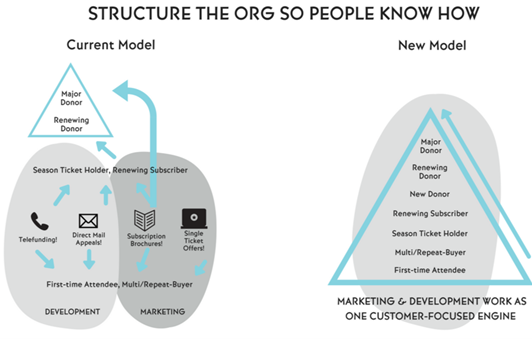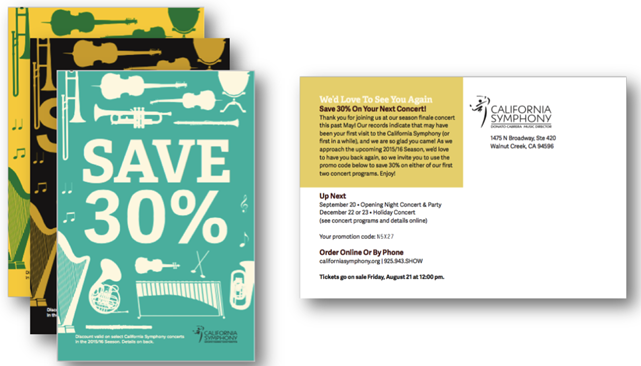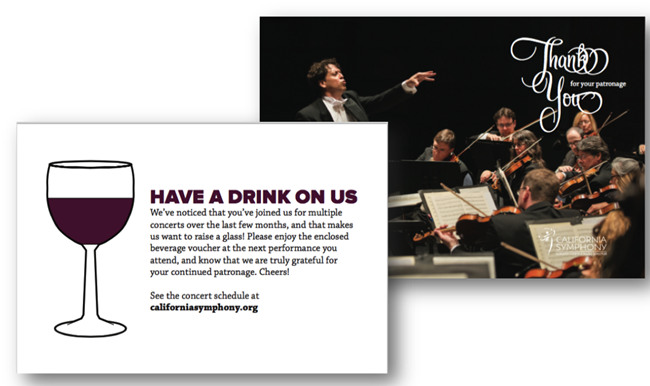The California Symphony: A case study on building audience loyalty
The challenge:
California Symphony was about to close their doors – sales and donations were down, concerts half-empty (or filled through comps), board parted ways. They knew they had to make organisation-wide changes and focus on audience retention. It took three years, but with hard work, their concert capacity averaged 89% and got a very loyal audience in the end (subscriber renewal rate was at 85%). Half of their subscribers also made donations.
What were some of the big changes?
- They learned the right and wrong metrics to use. The size of your audience database doesn’t mean anything. “Bigger is not always better, and bigger is almost always more expensive.”
- They realised that they had to change how they worked. They nixed working in silos, and focused on spending their hours doing things differently – “not adding more to the plate, but mixing up that plate a bit.”
How they changed their model
Firstly, they stopped working in silos – all worked as a cohesive team to focus on moving audience members up the loyalty ladder:

Next, they completely revamped their loyalty ladder to be more customer-focused.
“Now, no matter who you are, whether a first-time attendee, or repeat buyer, or new subscriber, or long time donor, or anywhere in between, we have a specific plan for you and a specific next step in mind, and everything we do points you toward that one next step and nothing else.”
What their plan was for each audience segment
First-timers segment:
- California Symphony send a postcard ASAP after they attend the first time, thanking them for joining + offering a discount for their choice of the next two concerts.
- One week later, they send them an email with the same information and discount code, and re-iterate a deadline on the discount.
- They don’t try to do subscription offers, donation appeals, etc. to this group, as the focus is just getting them to come back.
- They kept the branding simple on the postcard.

Multi-buyers segment (attend >once a year)
- Once they’ve attended a second time, they’re classed as multi-buyer. They’re now a lead for being a new season subscriber.
- 1 week after their second attendance, they send them a snail-mailed thank you card in an envelope. It says they’ve noticed they’ve joined them a few times recently, and here’s a voucher for a free glass of wine on their next visit. Deadline: before end of season.
- They’re now flagged in the database to be included in season ticket mailings
As people move up the loyalty ladder, communications with the audience become more ‘special.’ This time, it’s not just a postcard – it’s a card in an envelope, and has a photo of the orchestra and conductor. The reason? Someone has attended twice, so they may start to get to know the artists/conductors. The photo gives a more personal feel.

“the mental shift one makes after coming for the first time (“crossed that off my bucket list”) to coming a second time (“this is an activity I enjoy enough to repeat”) warrants the distinction in how we try to market to each group.”
How did they move people from multi-buyer to subscriber?
To convert audiences from a multi-buyer to a subscriber, they put them at the top of the queue to get their desired seats. They offered this segment subscriptions – you select your concerts and pay upfront for your desired seating selection. They took notes of their seating preferences (not too close to the front, outside aisle is best, etc.). When the renewal deadline for existing subscribers hit, these multi-buyers (who are new subscribers) were first in line to get their desired seat. It got people converted more quickly to a subscriber and they saw the benefits - being at top of the queue to get their desired seats.
They also protect those seats. When people ask why they can’t be assigned a seat yet (because it’s before the subscription deadline), they tell them it’s because first refusal goes to season ticket subscribers.
People like that those seats are protected – it means that their loyal audience is looked after, which gives people an incentive to sign up.
Overall, the results were good – after 3 years, California Symphony had a subscriber renewal rate of 85%, an average capacity of 89%, more people donating, and a younger audience. While this type of thing won’t work for everyone, the principles are still the same.
Practical learnings from this case study:
- Monitor your segments, thank your audiences, and offer them an incentive to come back.
- Targeted mailings (email and post) will not only save you money, but also maximise your ROI.
What’s impressive is that California Symphony generated $2-3k in one year from people attending ONE concert, off a total cost of $330. That’s $150 for the first-timer postcards + $75 for the multi-buyer cards + $105 beverage vouchers redeemed per concert.
Key takeaways:
- Get a better understanding of your audience – participating in our Foundations Report is just the first step. Segment your database to see just how loyal and engaged they are. Where are they on the loyalty ladder?
- Create a plan on how to move people up the loyalty ladder – how do you thank first time attenders? How do you convert them to engaged attenders? What do you need to do to make each step happen seamlessly?
- Stick with it. You won’t get results overnight, but given time, you’ll be on the right track to keep your audiences coming time and time again.
If you’d like to read up on all the juicy details of this case study, read their article.
If you need some help with your segmentation or would like to discuss your audiences' loyalty, we're always free for a chat. Book one of our audience appointments with our Client Programme Coordinator Úna Brady.

